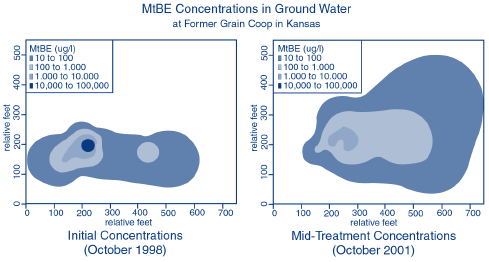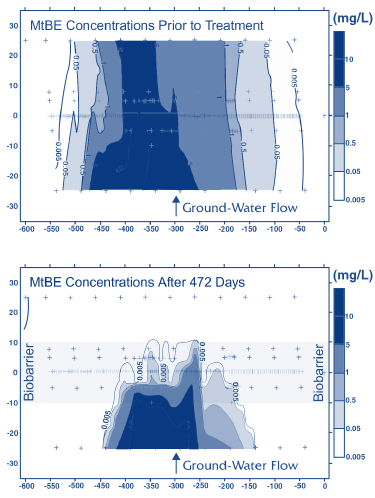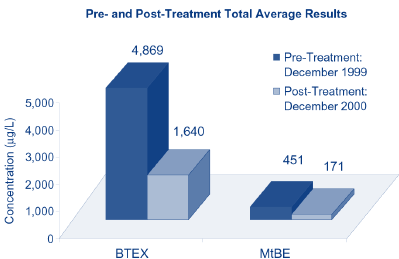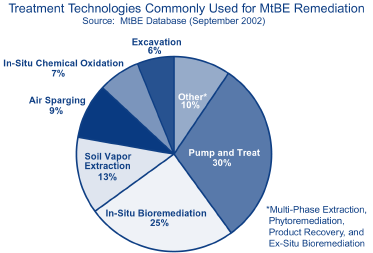Kansas UST Program Recommends SVE and AS for MtBE/BTEX Removal
Since the early 1990s, the Kansas Department of Health & Environment (KDHE) Storage Tank Program has worked aggressively to address dissolved phase MtBE and BTEX ground-water plumes associated with releases from underground storage tanks (USTs). Most of the UST sites where active remediation is ongoing or planned utilize soil vapor extraction (SVE) to enhance biodegradation of MtBE and BTEX. The approved remediation plans at many of these sites also include air sparging (AS). The KDHE has found that SVE and AS are more effective and less cumbersome technologies than ex-situ ground-water treatment processes.
More than 200 UST sites involving MtBE and BTEX contamination currently are undergoing active remediation using SVE and AS technologies. Of these, 34% show a reduction of MtBE concentrations to non-detect levels, and 25% show a reduction of benzene concentrations to non-detect levels. MtBE concentrations have decreased more than 90% at 65% of the sites, while benzene concentrations have decreased more than 90% at 66% of the sites.
Enhancement of bioremediation, rather than direct physical stripping or volatilization, is the primary focus of the KDHE’s remedial strategy at MtBE/BTEX sites. A combination of adequate vacuum extraction and relatively low amounts of injected air (usually less than 5 scfm) has enhanced bioremedation effectively. At sites where excavation of MtBE/BTEX-impacted soils is feasible, the KDHE recommends removal of source material as an integral part of any remedial option. Excavation and backfilling with a coarse material efficiently enhances airflow in the unsaturated zone and subsequent bioremediation in the capillary fringe. The KDHE also recommends dynamic implementation of SVE/AS systems, with design adjustments made as needed.
Successful results were achieved using this approach at a former grain coop in western Kansas. Following removal of 10 USTs between 1990 and 1997, investigations revealed MtBE concentrations of 92,000 µg/L and BTEX concentrations of 55,000 µg/L in ground water. Operation of a combined SVE/AS remediation system began at the coop in September 1998. The SVE system employs four wells, each with an applied vacuum of 50-70 in of water and a total extraction rate of 24-70 scfm. The system’s measured rate of influence (at 0.1 in of water vacuum) is 55 ft. The AS system employs nine wells through which air is injected in pulsed intervals at a rate of 0.0-2.0 scfm. Site soils consist of silt at depths of 1-45 ft below ground surface (bgs) underlain by sands to a depth of 55 ft bgs. The depth to ground water in this area fluctuates from 45 to 54 ft bgs.
Although the MtBE plume has expanded under the natural hydraulic gradient, total concentrations have decreased significantly (Figure 1). Following approximately four years of treatment, MtBE concentrations have decreased 97% and BTEX concentrations have decreased 96% (to 2,100 and 1,942 µg/L, respectively). SVE system effluent, which is monitored on a constant basis, has ranged from 2,379 mg/L at system startup to a current level of 61 mg/L. Nested monitoring wells continue to track potential migration of the contaminant plume toward two public water supply wells (located within 0.25 mi and downgradient of the source area). No evidence of contamination has been found in the supply wells.

The KDHE conducted a complete engineering evaluation of the remediation system in September 2002 to identify potential methods for optimizing and/or enhancing the existing design. Based on these findings, no major system modifications are anticipated until shutdown in 2004. The total project implementation cost to date is $74,000, with a cost of $46,000 expected for maintenance and monitoring over the next two years.
Contributed by Greg Hattan, KDHE (785-296-5931 or ghattan@kdhe.state.ks.us) and Seth Kostbar, KDHE (785-296-0642 or skostbar@kdhe.state.ks.us)
Biobarrier Treats Mixed MtBE Plume at Port Hueneme
Naval Facilities Engineering Service Center (NFESC) and Arizona State University (ASU) researchers are monitoring the performance of a 500-ft biobarrier installed in 2000 at the Naval Base Ventura County (NBVC) in Port Hueneme, CA. The demonstration indicates that MtBE, tertiary butyl alcohol (TBA), and benzene concentrations in ground water passed through the biobarrier each decrease by 99%, achieving less than 0.005 mg/L in downgradient areas. In recognition, the National Ground Water Association granted its 2001 Outstanding Ground Water Remediation Project Award to this effort, which is sponsored through the U.S. Department of Defense’s Environmental Security Technology Certification Program.
Several pilot-scale technology demonstrations were conducted recently at the NBVC to address a large MtBE plume resulting from past underground pipeline releases of gasoline. At a depth of 10-20 ft below ground surface (bgs), the 5,000- by 500-ft dissolved MtBE plume mixes with a smaller BTEX plume and sands contaminated from residual non-aqueous phase liquid. Concentrations of MtBE and total BTEX exiting the source zone each exceed 10,000 mg/L, while concentrations of TBA exceed 1,000 mg/L. A lower clay aquitard located 20 ft bgs bounds the aquifer, through which ground water flows at an average velocity of 1 ft/day.
Design of the Port Hueneme biobarrier is based on results from bioaugmentation and biostimulation pilot-scale studies conducted during 1998-2001 [described in the October 2001 issue of Ground Water Currents, available at www.clu-in.org]. The system contains a passive flow-through aerobic barrier through which ground water containing MtBE and TBA travels under natural gradient conditions. Oxygen gas or air is injected into the aquifer periodically to increase dissolved oxygen levels, thereby creating a zone conducive to aerobic biodegradation (biostimulation). Tailored bacterial cultures also were injected to further enhance MtBE degradation (bioaugmentation).
The biobarrier system includes 252 gas injection wells, 174 monitoring wells, 25 satellite gas storage tanks, 154 solenoid valves, a 240 ft3/hr-capacity oxygen generator, automated timer circuits, and associated piping and electrical lines. Gas injection wells were installed at 2-ft spacings with alternating screen depths of 18-20 ft bgs or 14-15 ft bgs. A modular barrier, incorporating 20-ft-wide oxygen delivery modules replicated at 25 positions, spans 500 ft along the downgradient edge of the source zone.
Since September 2000, oxygen gas has been injected four times a day through each of the 252 injection wells. A central area of the dissolved plume containing the highest MtBE and BTEX concentrations was inoculated with microbial cultures 85 days after the oxygen injections began. Inoculation was delivered to a depth of 9-20 ft bgs, within two 70-ft-long sections of the aquifer.
Monthly and bi-monthly sampling events have occurred since the injections began, with more than 200 ground-water samples collected during each event. Field analyses of MtBE and BTEX components are performed using gas chromatography and flame- and photo-ionization detectors. Due to the interference of co-eluting peaks in field-derived histograms, more complete TBA characterization is achieved using gas chromatography/mass spectroscopy techniques at an offsite laboratory.
Figure 2 provides representative contour plots illustrating pre-treatment and current concentrations of MtBE in the demonstration area. Contours of dissolved BTEX and TBA concentrations show similar trends. These results indicate that the biobarrier has reduced migration of the plume significantly, and has helped to degrade contaminants to non-detect (<0.005 mg/L) concentrations in ground water exiting the system.

Dissolved oxygen has increased from a pre-injection concentration below 1 mg/L to 10-35 mg/L throughout the target area, thereby increasing the potential for aerobic biodegradation to occur. In addition, increased dissolved oxygen levels upgradient of the treatment zone due to dispersion of the injected gas appear to cause upgradient reductions in MtBE and benzene concentrations. Peripheral wells showing no increase in MtBE concentrations confirm the flow of ground water and contaminants through, rather than around, the biobarrier.
Researchers also are investigating the spatial variability of MtBE-degrading activity occurring in the demonstration area, and have filmed two-dimensional visualization experiments to better understand bacterial distributions resulting from microbial inoculation. Performance monitoring of the biobarrier system will conclude in December 2002.
A preliminary cost comparison conducted with an existing pump and treat system at this site suggests savings of more than $34 million over the project life. The Los Angeles Regional Water Quality Control Board recently approved continued use of this biobarrier and installation of a second biobarrier (at the toe of the plume) as the final remedy for the NBVC MtBE plume.
Contributed by Karen Miller, NFESC (805-982-1010 or millerkd@nfesc.navy.mil), Paul Johnson, ASU (480-965-9115 or paul.c.johnson@asu.edu), and Cristin Bruce, ASU (480-965-8130 or criddley@hotmail.com)
Accelerated BTEX/MtBE Destruction Achieved through Chemical Oxidation
The Town of Harrison, NY, and private industry recently collaborated in efforts to expedite ground-water cleanup at a municipal site adjacent to property scheduled for residential development. Investigations at this West Chester, NY, site, which formerly housed a public works garage, discovered BTEX and MtBE concentrations in ground water reaching 4,869 µg/L and 451 µg/L, respectively. Cleanup was challenged further by the site’s steep grades and underlying bedrock.
Petroleum leaks from an underground storage tank operating on the 100-acre property created a 2,400-sq-ft BTEX plume in the source area and a 17,600-sq-ft downgradient MtBE plume. The subsurface consists of very fine to coarse sand and gravel with occasional cobbles and an estimated ground-water flow rate of 0.23 ft3/day/ft2. The sand and gravel is underlain by highly weathered and fractured bedrock at 11-17.5 ft below ground surface (bgs). The depth to the water table ranges from 3 to 10 ft bgs.
Following site-specific laboratory studies that achieved non-detect concentrations of BTEX and MtBE, the ISOTECSM modified Fenton’s reagent in-situ chemical oxidation (ISCO) process was selected as the remedial alternative for the site. The process involves the injection of hydrogen peroxide and chelated iron catalysts directly into the subsurface. Together, the chelated iron catalysts and stabilized hydrogen peroxide promote generation of reactive hydroxyl radicals under neutral pH conditions. The aqueous radicals react with organic materials to produce non-toxic by-products such as carbon dioxide and water.
Unlike remediation technologies based on the conventional Fenton’s reaction, the ISOTEC process does not employ acidic additives, which hinder the natural attenuation process. Once equilibrium is achieved, contaminant concentrations typically decrease further due to natural attenuation and other physical processes occurring within the aquifer. The ISOTEC process also enhances subsurface mobility of injected reagents, which is needed for greater radial coverage of treated areas.
Injections at the West Chester site were performed in two 10-day phases conducted in June and November 2000. Reagents were injected into both bedrock plumes, within a 20,000-sq-ft treatment area on hilly terrain. The first phase involved injection of 1,700 gal of hydrogen peroxide and 760 gal of catalyst into 23 injection wells, at a rate of 1.64 gal/min. In the second phase, 2,500 gal of hydrogen peroxide and 1,200 gal of catalyst were injected into 21 wells. In addition, 76 direct-push points positioned in a 10-ft grid pattern were used to treat the contaminated interval, located 11-20 ft bgs. A total of 2,400 gal of hydrogen peroxide and 1,300 gal of catalyst was injected at an average rate of 0.89 gal/min at these points.
Field monitoring activities were conducted at 12 sampling locations one month after each of the two injection events. Project results indicated a 66% decrease in the total average BTEX concentration and a 62% decrease in the total average MtBE concentration (Figure 3). Treatment costs for this project totaled $150,000, or approximately $20.24/yd3 of contaminated ground water. Costs were significantly lower than the $1.5-2 million required for implementation of an alternative (5- to 7-year) pump and treat system.

Through the use of ISCO with modified Fenton’s reagent, ground-water contaminants dropped within 13 months. The New York State Department of Environmental Conservation subsequently determined that the site required no further remedial action, and the adjacent property development will proceed as planned. This accelerated cleanup project received the New York Association of Consulting Engineers’ Diamond Award and the American Council of Engineering Companies’ National Recognition Award.
Other applications have shown the ISOTEC process effective in addressing significantly higher concentrations of MtBE. [For more information, view EPA/TIO’s MtBE Treatment Profiles at www.clu-in.org/products/mtbe]. Additional studies are underway to evaluate this technology’s effectiveness in removing other recalcitrant volatile and semivolatile organic compounds, as well as organic pesticides.
Contributed by Prasad Kakarla, In-Situ Oxidative Technologies, Inc. (609-275-8500 or prasad.kakarla@isotec-online.com), Anthony Catalano, Malcolm Pirnie (914-641-2643 or acatalano@pirnie.com), and Robert Wasp, Town of Harrison (914-835-2000 or dpwwasp@aol.com)
Phytoremediation Field Studies Underway for MtBE Removal
University of Iowa and Equilon Enterprises, Inc. researchers are evalu-ating the performance of phytoremediation in treating MtBE-contaminated ground water at a former gas station in Houston, TX. Approximately 1,000 hybrid poplar trees were planted at the site in February 1998 across a 1.7-acre treatment area. Current field results demonstrate that significant MtBE uptake in the poplar roots has taken place and that phytohydraulic containment of the plume is possible.
Prior to treatment, MtBE concentrations in the 60- by 300-ft plume at the study site were approximately 46 mg/L. Using 1-ft-diameter holes to penetrate clay and reach the sandy aquifer, 6-foot trees were planted at 8-ft intervals in staggered rows. Tree whips were placed immediately above the capillary fringe of the water table (at 6-9 ft below ground surface) with 0.5-1 ft exposed above ground. Backfill consisted of a fertilizer-amended mixture of 60% sand and 40% mulch.
By August 1999, the mean height of the planted poplars was 11.7 ft and the roots of upgradient trees had reached 14-15 ft into shallow ground water. MtBE transpiration was estimated in the field by placing plexiglass chambers around the tree branches. Less than 10% of the MtBE mass proportionately taken up by the trees was captured in the chambers during 4-hour incubations, indicating that MtBE primarily is stored in the plant tissues and/or metabolized rather than transpired through leaves. Additional field analysis indicates non-detect levels of contaminant potentially released to the air as a result of transpiration.
Modeling indicates that MtBE concentrations in the plume should decrease more than 90% by the end of next year. Monitoring of the project is anticipated to extend through 2003. More information can be found through EPA’s MtBE Treatment Profiles at www.clu-in. org/products/mtbe.
Contributed by Jerry Schnoor, University of Iowa/Department of Civil Engineering (319-335-5649 or e-mail jerald-schnoor@uiowa.edu)
TIO Develops MtBE Treatment Profiles
To enhance dissemination of information on technologies for treating soil and ground water contaminated with MtBE, the U.S. EPA’s Technology Innovation Office (TIO) has compiled profiles of technology applications completed or underway at sites across the country. These treatment profiles are available on-line in the MtBE database at www.clu-in.org/products/ mtbe.
The MtBE database currently contains more than 300 site-specific treatment profiles submitted from 30 states. Of these, 85 profiles address sites in the State of Kansas. Other states for which significant numbers of MtBE treatment profiles are available include California (60) and South Carolina (51). Each profile describes a specific site, design and operation of the selected technology, project imple-mentation costs, performance of the technology, and points of organizational contact. Pump and treat technology and in-situ bioremediation account for more than half of the (non drinking-water treatment) profiles (Figure 4).

TIO invites technology users to submit new profiles or update existing profiles directly online.
To obtain more information or provide user feedback on the MtBE Treatment Profiles, contact Linda Fiedler at TIO (703-603-7194 or fiedler.linda@epa.gov)






